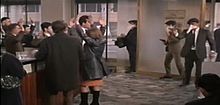Poliziotteschi

Poliziotteschi (Italian:
Etymology of the noun
In Italian, poliziesco is the grammatically correct Italian adjective (resulting from the fusion of the noun polizia, "police", and the
Instead the term poliziottesco, a fusion of the words poliziotto ("policeman") and the same -esco desinence, has prevailed (over the more syntactically correct poliziesco all'italiana) to indicate 1970s-era Italian-produced "tough cop" and crime movies. The prevalence of poliziottesco over poliziesco all'italiana closely follows the success of the term spaghetti Western over western all'italiana, being shorter and more vivid – though in both instances the term that has come to be used more frequently by English-speaking fans of the genre (poliziotteschi, spaghetti Westerns) was originally used pejoratively by critics, to denigrate the films themselves and their makers.
History

Although the subgenre has its roots in Italian
Just as American police films, American crime thrillers, and American vigilante films of the time focused on the crime waves and urban decline in the United States of the 1960s and 1970s, poliziotteschi were set in the context of, or directly addressed, the sociopolitical tumult and violence of Italy's

Due in part to the genre's often ostensibly negative portrayal of political activists and militants, especially leftist militants, and its seeming endorsement of
In retrospect, despite contemporaneous claims in the 1970s of overly conservative or reactionary themes within the genre, film historians such as Louis Bayman and Peter Bondarella contend that, in fact, poliziotteschi films generally presented a more multi-faceted, complex outlook on the political turmoil and crime waves of the time, as well as violence in general, with Bayman and author Roberto Curti in particular arguing that the genre generally used political conflicts and violence for largely

With directors such as
Although based around crime and detective work, poliziotteschi should not be confused with the other popular Italian crime genre of the 1970s, the giallo, which, to English-speaking and non-Italian audiences, refers to a genre of violent Italian murder-mystery thriller-horror films. Directors and stars often moved between both forms, and some films could be considered under either banner, such as Massimo Dallamano's What Have They Done to Your Daughters? (1974).
The poliziottesco subgenre gradually declined in popularity during the late 1970s. Screenwriter
Directors include
- Mario Bianchi
- Alfonso Brescia
- Enzo G. Castellari
- Bruno Corbucci
- Damiano Damiani
- Alberto De Martino
- Massimo Dallamano
- Ruggero Deodato
- Lucio Fulci
- Mario Caiano
- Marino Girolami
- Romolo Girolami
- Umberto Lenzi
- Fernando Di Leo
- Carlo Lizzani
- Sergio Martino
- Stelvio Massi
- Giuliano Montaldo
- Elio Petri
- Sergio Sollima
- Duccio Tessari
Actors include
- Mario Adorf
- Ursula Andress
- Carroll Baker
- Martin Balsam
- Helmut Berger
- Barbara Bouchet
- Sal Borgese
- Marcel Bozzuffi
- Charles Bronson
- Luciano Catenacci
- Adolfo Celi
- Giovanni Cianfriglia
- Joan Collins
- Richard Conte
- Joseph Cotten
- Alain Delon
- George Eastman
- Mel Ferrer
- Klaus Kinski
- Angelo Infanti
- Leonard Mann
- Luc Merenda
- Maurizio Merli
- Mario Merola
- Tomas Milian
- Gordon Mitchell
- Gastone Moschin
- Franco Nero
- Jack Palance
- Oliver Reed
- Fernando Rey
- Edward G. Robinson
- Luciano Rossi
- Antonio Sabàto Sr.
- Telly Savalas
- John Saxon
- Henry Silva
- Woody Strode
- Fabio Testi
- Massimo Vanni
- Gian Maria Volonté
- Eli Wallach
- Fred Williamson
Selected films
|
|
See also
References
- ^ a b The Best Cop Movies You’ve Never Heard Of: ‘Poliziotteschi’ Films Get Their Due|IndieWire
- ^ a b Violent Italy: A Poliziotteschi Primer|Birth.Movies.Death.
- ^ ISBN 9781476612089.
- ^ ISBN 9781137305657. Retrieved 6 December 2015.
- ISBN 9788862921084.
- ^ ISBN 9781441160690.
- ISBN 9781841504001.
- ^ Canby, Vincent (1974-08-04). "Screen: 'Death Wish' Exploits Fear Irresponsibly; 'Death Wish' Exploits Our Fear". The New York Times. Retrieved 2011-11-06.
- ^ Canby, Vincent (1974-07-25). "Screen: 'Death Wish' Hunts Muggers:The Cast Story of Gunman Takes Dim View of City". The New York Times. Retrieved 2011-11-06.
- ISBN 9788888375663.
- ^ Christian Uva, Michele Picchi, Destra e sinistra nel cinema italiano. film e immaginario politico dagli anni '60 al nuovo millennio, Edizioni interculturali, 2006, p. 90
- ^ a b The Best Poliziotteschi Movies of All Time - Flickchart
Further reading
- ISBN 978-8871805863.
- Daniele Magni, Silvio Giobbio, Ancora più... Cinici infami e violenti – Guida ai film polizieschi italiani degli anni '70, Bloodbuster Edizioni, 2010, ISBN 978-8890208744.
External links
- Poliziotteschi – The Final Take at Allmovie
- Pollanet Squad – poliziotteschi data base (in Italian)
- RDB Article (in Portuguese)

